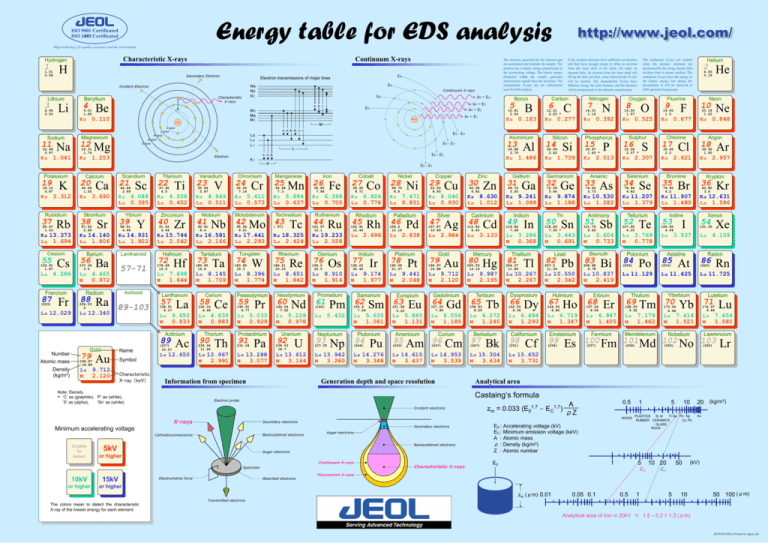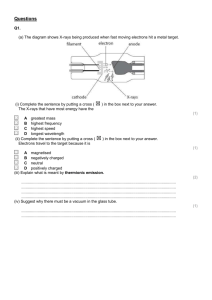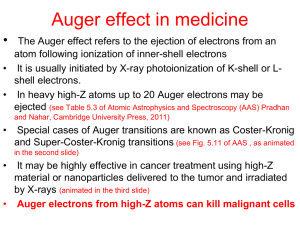Energy table for EDS analysis
advertisement

Energy table for EDS analysis ISO 9001 Certificated ISO 14001 Certificated http://www.jeol.com/ http://www.jeol.com/ High technology for quality assurance and the environment Characteristic X-rays Hydrogen 1 1.01 0.08 H Continuum X-rays Secondary Electron Lithium 3 6.94 0.53 Li 4 Be 9.01 1.85 Nucleus 22.99 0.97 Na 1.041 Kα 39.10 0.87 3.312 Kα Rubidium 37 85.47 1.53 Rb Ca 40.08 1.55 Kα 3.690 Strontium 38 Sr 87.62 2.60 21 44.96 2.99 Kα Lα Sc 4.088 0.395 Yttrium 39 88.91 4.48 Y Titanium 22 Ti 47.90 4.5 4.508 0.452 Kα Lα Zirconium 40 Zr 91.22 6.44 Vanadium 23 V 50.94 5.87 4.949 0.511 Kα Lα Niobium 41 Nb 92.91 8.4 5.411 0.573 Kα Lα Molybdenum 42 95.94 9.01 Mo Manganese 25 54.94 7.3 Mn Kα 5.894 Lα 0.637 Technetium 43 Tc ( 97) Kα 14.140 Lα 1.806 Kα 14.931 Lα 1.922 Kα 15.744 Lα 2.042 Kα 16.581 Lα 2.166 Kα 17.441 Lα 2.293 Kα 18.325 Lα 2.424 Cesium Barium Lanthanoid Hafnium Tantalum Tungsten Rhenium 55 Cs 4.286 Lα Francium 87 (223) Fr Lα 12.029 56 Ba 137.34 3.5 57-71 Lα 4.465 M 0.972 Actinoid Radium 88 Ra 226.03 5 Lα 12.340 89-103 72 Hf 178.49 13.3 7.898 1.644 Lα M Lanthanum Number Atomic mass Density (kg/m3) Gold 79 196.97 18.88 Lα M Au 9.712 2.120 Name Symbol Characteristic X-ray (keV) 8.145 1.709 Lα M Cerium 58 58 Ce 4.650 0.833 Lα M 4.839 0.883 Actinium 89 Ta La 57 138.91 6.17 Lα M 73 180.95 16.6 (227) 10.07 Ac Lα 12.650 140.12 6.66 Thorium 90 232.04 11.00 Th Lα 12.967 M 2.991 74 183.85 19.3 W 8.396 1.774 Lα M Praseodymium 59 140.91 6.77 Pr Lα 5.033 M 0.929 Protactinium 91 231.04 Pa Lα 13.288 M 3.077 75 Re 186.21 20.53 Lα 8.651 M 1.842 Neodymium 60 144.24 7.02 Lα M Nd 5.229 0.978 Uranium 92 238.03 18.7 U Lα 13.612 M 3.164 Information from specimen Note: Density * ‘C’ as (graphite), ‘P’ as (white), ‘S’ as (alpha), ‘Sn’ as (white) Iron 26 Fe 55.85 7.86 6.398 0.705 Kα Lα Ruthenium 44 Ru 101.07 12.1 Kα 19.233 Lα 2.558 Osmium 76 190.2 22.5 Lα M Os 8.910 1.914 Cobalt 27 61 Pm Lα 5.432 Rhodium 45 93 Np Lα 13.942 M 3.260 Rh 102.91 12.44 2.696 Lα Iridium 77 Ir 192.22 22.42 Lα M 9.174 1.977 Samarium 62 150.4 7.54 Lα M Neptunium 237.05 6.924 0.776 Kα Lα Prometium (145) Co 58.93 8.71 Sm 5.635 1.081 Plutonium 94 (244) Pu Lα 14.276 M 3.348 Nickel 28 58.70 8.8 Ni Kα 7.471 Lα 0.851 Palladium 46 106.4 12.16 Pd Lα 2.838 Platinum 78 195.09 21.37 Pt Lα 9.441 M 2.048 Europium 63 151.96 5.25 Eu Lα 5.845 M 1.131 Copper 29 Cu 63.55 8.93 8.040 0.930 Kα Lα Silver 47 Ag 107.87 10.49 2.984 Lα Gold 79 Au 196.97 18.88 9.712 2.120 Lα M Gadolinium 64 Gd 157.25 7.90 Lα M Americium 6.056 1.185 Curium 95 Am 96 Cm (243) (247) Lα 14.615 M 3.437 Lα 14.953 M 3.539 Generation depth and space resolution X-rays Secondary electrons Backscattered electrons Cathodoluminescence Auger electrons Backscattered electrons 5kV 5kV Auger electrons or orhigher higher Continuum X-rays Specimen or orhigher higher 15kV 15kV Electromotive force Absorbed electrons or orhigher higher The colors mean to detect the characteristic X-ray of the lowest energy for each element. 7 C 0.277 Kα Silicon 14 Si 28.09 2.42 1.739 Kα Oxygen 8 N 14.01 1.14 0.392 Kα Phosphorus 15 30.97 1.83 * P 2.013 Kα Transmitted electrons O 16.00 1.57 Kα 0.525 Sulphur 16 S 32.06 2.07 * Kα 2.307 Zinc 30 Zn 65.38 6.92 8.630 1.012 Kα Lα Cadmium 48 Cd 112.40 8.65 3.133 Lα Mercury 80 Hg 200.59 14.19 9.987 2.195 Lα M Terbium 65 158.93 8.25 Lα M Tb 6.272 1.240 Berkelium 97 (247) Bk Lα 15.304 M 3.634 Gallium 31 Ga 69.72 5.93 9.241 1.098 Kα Lα Indium 49 In 114.82 7.28 Lα M 3.286 0.368 Thallium 81 Tl 204.37 11.86 Lα 10.267 M 2.267 Dysprosium 66 162.50 8.56 Dy 6.494 1.293 Lα M Californium 98 (251) Cf Germanium 32 Ge 72.59 5.46 9.874 1.188 Kα Lα 50 Tin Sn Arsenic 33 2 Fluorine 9 Neon 10 F 19.00 1.5 Argon 18 Cl 35.45 2.2 Ar 39.95 1.65 2.621 Kα 0.848 Kα Chlorine 17 Ne 20.18 1.20 0.677 Kα He 4.00 0.19 2.957 Kα Pb Lα 10.550 M 2.342 Holmium 67 164.93 8.80 Lα M Ho 6.719 1.347 Einsteinium 99 (254) Es Characteristic X-rays 36 Br 79.90 4.2 Kr 83.80 3.4 Kα 12.631 Lα 1.586 Antimony Tellurium Iodine Xenon 51 Lα M 82 35 Kα 11.907 Lα 1.480 Lα M 207.2 11.34 Se 78.96 4.82 Krypton Kα 11.207 Lα 1.379 121.75 6.62 Lead 34 Bromine Kα 10.530 Lα 1.282 118.69 7.30 * 3.443 0.691 As 74.92 5.73 Selenium Sb 3.604 0.733 Bismuth 83 Bi 208.98 9.78 Lα 10.837 M 2.419 Erbium 68 167.26 9.06 Lα M Er 6.947 1.405 Fermium 52 Te 127.60 6.25 Lα 3.769 M 0.778 Polonium 84 Po (209) Lα 11.129 Thulium 69 168.93 9.32 Tm 7.179 1.462 Lα M 53 54 I 126.90 4.94 85 Radon 86 At Lα 11.725 Ytterbium 70 Lutetium 71 Yb 174.97 9.84 7.414 1.521 Lα M Rn (222) Lα 11.425 173.04 6.96 4.109 Lα Astatine (210) Xe 131.30 3.937 Lα Mendelevium (257) (258) Lu Lα 7.654 M 1.581 Lawrencium Nobelium 100 Fm 101 Md 102 No 103 (255) (262) Lr Lα 15.652 M 3.731 Analytical area 0.5 A zm = 0.033 (E01.7 - EC1.7) ρZ WOOD Secondary electrons Minimum accelerating voltage 10kV 10kV 6 12.01 2.25 * Nitrogen Castaing’s formula Electron probe Incident electrons Unable Unable to to detect detect 1.486 Kα Carbon Helium The continuum X-rays are emitted when the primary electrons are decelerated by the strong electric field existing close to atomic nucleus. The continuum X-rays have the energy of the kinetic energy lost during the deceleration. It will be observed as EDS spectrum background. If the incident electrons have sufficient acceleration and then have enough energy to strike an electron from the inner shell of the atom, it'll make an electron hole. An electron from the outer shell will fill up the hole and then, some characteristic X-rays will be emitted. The characteristic X-rays have different energy for each element, and the intensity will be proportional to the element concentration. E0 - E1 Kα 13.373 Lα 1.694 132.91 1.87 Al 26.98 2.70 E0 - E2 K Cr 52.00 7.14 13 L Chromium 24 Aluminium E0 - E3 KⅠ B 0.183 Kα E0 - E4 α1 α2 β1 Electron Kα 1.253 20 K α1 α2 β1 β2 γ1 γ3 O shell Scandium 5 10.81 2.54 hv = E1 Nucleus LⅢ LⅡ LⅠ N shell Mg 24.31 1.74 Calcium Potassium 19 12 Boron M M shell Magnesium hv = E4 hv = E3 hv = E2 E0 MⅤ・ MⅢ・ MⅠ K shell L shell 11 Continuum X-rays E0 α1 β γ ζ Kα 0.110 Sodium E0 NⅦ : NⅣ : NⅠ Characteristic X-rays Beryllium E0 Electron transmissions of major lines Incident Electron The electrons generated by the electron gun are accelerated and irradiate the sample. The electron has a kinetic energy proportional to the accelerating voltage. The kinetic energy dissipated within the sample generates characteristic signals from the specimen. The characteristic X-rays are the information used for EDS analysis. E0 : EC : A : ρ: Z : Accelerating voltage (kV) Minimum emission voltage (keV) Atomic mass Density (kg/m3) Atomic number 1 E0 1 5 EC 0.05 0.1 0.5 20 (kg/m3) 10 Ti Ge Fe Ag PLASTICS Si Al Cu Pb RUBBER CERAMICS GLASS ROCK Fluorescent X-rays zm (μm) 0.01 5 1 10 20 50 Au (kV) E0 5 10 50 100 (μm) Analytical area of iron in 20kV ≒ 1.5 – 0.2 = 1.3 (μm) JEC6101C602A Printed in Japan, Ks







